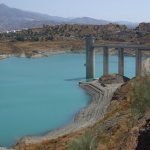Irrigation was brought to Spain by the Arabs in the 8th Century and was developed over the following 750 or so years into the quite sophisticated systems that even today keep agriculture alive and well throughout the peninsula. Paul Whitelock has recently found out all about irrigation – the hard way
ACEQUIAS, acogidas, albercas, alcantarillas, aljibes y arquetas.
These six words all have something to with irrigation (riego) and water management and, since it was the Arabs who introduced irrigation to Spain, it’s no surprise that five of the above words are Arabic in origin.
When we first moved to the campo I’d heard the words but wasn’t at all sure what any of them were exactly. But now I’m a bit of an expert having just had the irrigation system running from the nacimiento (natural spring) up the hill renewed.
Soon after we moved in in February we discovered we had a flooding problem in our garden. There is so much water round here, with several natural springs flowing all year round and a high water table, that all this H2O had to end up somewhere, and with our antiquated system having fallen into disrepair, with blocked and broken pipes, it was our back lawn, the lowest point, that became a massive lake whenever rain added more volume to what was already in the ground.
Something had to be done before the winter rains. With the help of neighbour Juan Antonio’s JCB and new gardener Rafael’s manual labour, we now have a completely new system.
Technical jargon
Before we go any further, however, let’s check out the meanings of these key words.
Acequia , n.f. – irrigation ditch or channel
Acogida, n.f. – sunken bed
Alberca, n.f. – tank, reservoir
Alcantarilla, n.f. – sewage pipe
Aljibe, n.m. – cistern, tank (principally for drinking water)
Arqueta, n.f. – (lit. chest) partly underground junction chamber for irrigation pipes
New system
The new system works like this. Water from a natural spring entering our field at the top from the next door neighbour’s land enters an arqueta with two exit pipes, one underground and one above ground for irrigation at the top of the field, if required. The underground pipe runs to a second, larger arqueta about 20 metres away which also receives water from La Fuente de la Higuera, a major natural spring after which this area is named.
The exit pipe from this arqueta runs into an alberca which can store up to 45 cubic metres of water (some 45,000 litres). By opening a valve with a tap at the base of this giant container, I can draw water from the alberca which then runs downhill, underground, for some 100 metres to yet another arqueta located at the upper edge of my vegetable garden. From here I can draw water via a web of acequias which run into the sunken beds (acogidas) where my vegetables grow.
Excess water is diverted underground into a concrete acequia which leads the water away from my lawn and down into the River Guadalcobacín at the bottom of the valley.
It’s due to rain any day now, so we shall see whether it works and whether our lawn no longer becomes a lake. Fingers crossed.
Domestic water
Our domestic water comes from a well (pozo) at the bottom of the garden. The water is pumped to an aljibe, an underground cistern in a little outbuilding which also houses the filter and another pump which takes the water to the house. If anything goes wrong with this system, which it did in July, we can draw water into the aljibe from a communal well nearby.
Waste water from the house flows through alcantarillas into the main sewer which runs …. where? According to neighbours it goes straight into the River Guadalcobacín untreated! But that can’t be right, can it ….?






Paul should be made aware that when the Romans settled in Andalucia around 2000 years ago and decidedly earlier than the Moors arrived, they not only developed the Olive oil business but introduced fantastic water irrigation systems. I recently walked up to an awesome Roman water collection tank collection on top of a hill overlooking farmlands. Not far away was the start of the clay pipe running from a natural spring about 70 kms as far as Cadiz.
Hi, Nigel
Yes, you’re right, but it was the Moors who really moved irrigation along. The current agricultural infrastructure uses the Arab methods, hence the preponderance of Arab words.